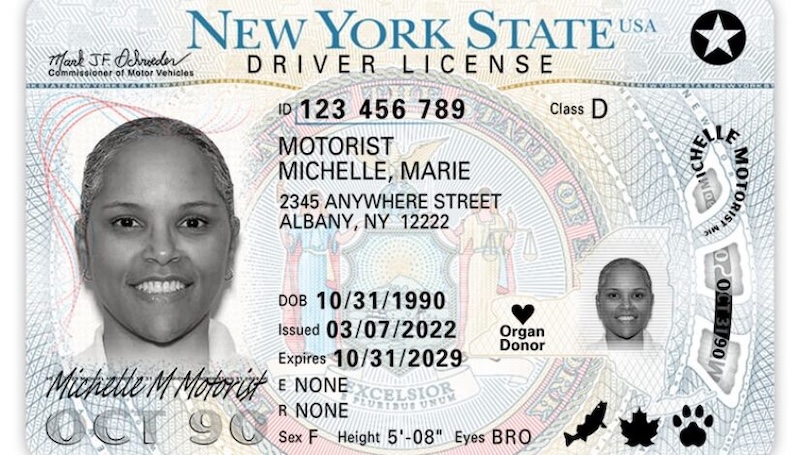If you’re planning a cruise, you may be wondering, or stressing out over, whether a Real ID is required to set sail. With ever changing travel regulations, it’s a valid question. This article clarifies what a Real ID is, when it’s required, whether it’s necessary for cruises in the United States, and why a passport is always the best form of identification for your cruise adventure.
What Is a Real ID?
The Real ID Act, passed by Congress in 2005, set federal standards for state-issued driver’s licenses and identification cards to enhance security. A Real ID-compliant license or ID typically features a star (or another state-specific symbol) in the upper corner. The goal is to ensure that identification used for certain federal purposes is reliable and secure.

As of May 7, 2025, the Department of Homeland Security (DHS) requires Real ID-compliant identification for specific types of travel and access to certain federal facilities. However, not all travel scenarios require a Real ID, and cruising is a prime example where the rules differ.
When Is a Real ID Required?
A Real ID is primarily required for:
-
Domestic Air Travel: If you’re flying within the United States (including to U.S. territories like Puerto Rico or the U.S. Virgin Islands), you need a Real ID-compliant driver’s license or another acceptable form of identification (such as a passport) to board commercial flights.
-
Accessing Federal Facilities: Real ID is necessary for entering secure federal buildings, such as military bases or courthouses, where identification is verified.
-
Nuclear Power Plants: Though rare for most travelers, access to these facilities also requires a Real ID.
For other forms of travel—like driving, taking a train, or boarding a cruise ship—a Real ID is not explicitly required unless you’re using it as your sole form of identification in a scenario where alternative IDs (like a passport) are not presented.
Do I Need a Real ID for a Cruise?
The good news for cruisers is that a Real ID is not required to board a cruise in the United States. Cruise lines operate under different regulations than domestic air travel, and they accept a variety of identification documents. Whether you’re embarking on a domestic cruise (e.g., a round-trip cruise from a U.S. port to destinations like Alaska, Hawaii, or the Bahamas) or an international cruise, a Real ID-compliant driver’s license is not mandatory.
Here’s a breakdown of cruise scenarios:
-
Closed-Loop Cruises (U.S. Round-Trip): These cruises start and end at the same U.S. port and often visit destinations in the Caribbean, Mexico, Canada, or Bermuda. For U.S. citizens, a Real ID is not needed. Instead, you can use a government-issued photo ID (like a standard driver’s license) and proof of citizenship, such as a birth certificate. However, a passport is highly recommended (more on that below).
-
International Cruises (One-Way or Non-U.S. Ports): These cruises may start or end at a foreign port or involve international destinations. A passport is typically required, as it’s the universally accepted form of identification for international travel. A Real ID alone won’t cut it in these cases.
-
Cruises Requiring Air Travel: If you’re flying to your cruise’s departure port (e.g., from a U.S. city to Miami or New York), you’ll need a Real ID-compliant ID or another acceptable form of ID (like a passport) to board your domestic flight. Once at the port, the cruise line’s identification requirements take over, and a Real ID is not specifically needed for embarkation.
In short, while a Real ID may be useful for getting to the port (if flying), it’s not a requirement for boarding a cruise itself. Cruise lines prioritize other forms of identification, with passports being the gold standard.
Why a Passport Is the Best Form of Identification for a Cruise
While a Real ID or other government-issued ID may suffice for some cruises, a valid U.S. passport is the best and most versatile form of identification for cruising. Here’s why:
-
Universal Acceptance: A passport is recognized worldwide and meets the identification requirements for all cruise types—domestic, international, closed-loop, or one-way. It eliminates confusion about whether your ID will be accepted at embarkation or in foreign ports.
-
International Port Requirements: Many cruise destinations, even on closed-loop cruises, require a passport for entry at foreign ports. For example, countries like Barbados or Jamaica may ask for a passport during shore excursions or immigration checks. Without one, you could face delays or be denied entry.
-
Emergency Situations: If you need to disembark unexpectedly in a foreign country (e.g., due to a medical emergency or missed ship departure), a passport is essential for re-entering the U.S. or arranging alternative travel. A driver’s license or birth certificate won’t suffice for international air travel or consular assistance.
-
Streamlined Processes: Cruise lines and port authorities process passports faster because they’re standardized and include machine-readable data. This can speed up embarkation and disembarkation, letting you start your vacation sooner.
-
Future-Proofing: Travel regulations can change, and some destinations are tightening identification requirements. A passport ensures you’re prepared for any last-minute itinerary changes or new rules.
-
Versatility for Pre- or Post-Cruise Travel: If your cruise involves flying to the departure port or extending your trip with land-based travel, a passport covers all bases—domestic flights, international borders, and cruise requirements.
Passport Tips for Cruisers
-
Check Validity: Ensure your passport is valid for at least six months beyond your cruise’s end date, as some countries require this.
-
Bring a Copy: Carry a photocopy of your passport’s photo page and store it separately in case the original is lost or stolen.
-
Keep It Safe: Use your cabin’s safe to store your passport during the cruise, and carry only a copy or alternative ID for shore excursions unless the physical passport is explicitly required. A quick check at the shore excursion desk onboard will provide an answer or if this is a requirement, a note will more than likely appear in the daily planner.
-
Consider a Passport Card: For closed-loop cruises in the Western Hemisphere, a U.S. passport card is a cheaper, wallet-sized alternative to a full passport book. However, it’s not valid for air travel or all destinations, so check your itinerary.
You don’t need a Real ID to take a cruise, whether it’s a domestic or international voyage. While a Real ID is critical for domestic flights and certain federal access, cruise lines accept other forms of identification, with passports being the most reliable and versatile option. For peace of mind, pack your passport!
